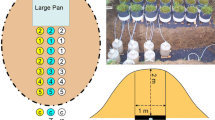Abstract
Core soil samples were collected from nine operating turkey buildings with different ages located in areas of different soil types in Minnesota. These samples were analyzed for pH, phosphorus, organic matter, ammonium nitrogen, and nitrate nitrogen to investigate the potential of groundwater pollution by turkey operations. According to the data, for clay loam soil, the chance of leaching of phosphorus to groundwater is slight if the water table is 153 cm below the ground surface. Saturation of ammonium nitrogen in the topsoil can be reached in 20 yr of continuous operation. Therefore, it may be suggested that the topsoil layer in turkey buildings be replaced every 20 yr for areas of high groundwater (within 91 cm or so), and every 40 yr for areas with low groundwater (greater than 153 cm in depth). Also for clay loam soil, the nitrate nitrogen may be able to move down in soil about 91 cm deep in ten years. For barns older than ten years, it is observed that the nitrate nitrogen concentrations are significantly higher inside than outside of barns throughout the entire sampling depth. As a preventive option for turkey producers for nitrate nitrogen in particular, replacing the topsoil layer every ten years may be helpful to obviate the potential pollution of groundwater resource by nitrate leaching. Similar measures may also be applied to loam soil. Due to limited data, the performance of silt and sandy loam soils in preventing nutrient leaching cannot be determined and should receive further research.
Similar content being viewed by others
References
Andres, A. S.: 1991, ‘Estimate of Nitrate Flux to Rehoboth and Indian River Bays, Delaware, through Direct Discharge of Ground Water’, Open File Report No. 35, Delaware Geological Survey, Newark, DE.
Denver, J.M.: 1991, ‘Groundwater-sampling Network to Study Agrochemical Effects onWater Quality in the Unconfined Aquifer’, Chapter 7, in R. G. Nash and A. R. Leslie (eds), Groundwater Residue Sampling Design, American Chemical Society Symposium Series No. 45, pp. 139–149.
Gee, G. W. and Bauder, J. W.: 1986, ‘Particle-size Analysis’, in Methods of Soil Analysis, Part 1. Physical and Minerological Methods. American Society of Agronomy, Soil Science Society of America, 677 South Segoe Road, Madison, WE 53711, pp. 383–411.
Haberstroh, G.: 1997, Nitrogen Concentrations under Turkey Barn Floors, Report for North Dakota Department of Health, Bismarck, ND.
Lomax, K. M., Malone, G. W., Gedamu, N. and Chirnside, A.: 1995, Soil Nitrogen Concentrations Under Broiler Houses, ASAE Paper No.: 952500, American Society of Agricultural Engineers, St. Joseph, MI.
Ritter, W. F.: 1991, ‘Movement of Nitrogen in Poultry Houses’, Technical Report for Delaware Department of Natural Resources and Environmental Control, Department of Agricultural Engineering, University of Delaware.
Ritter,W. F. and Chirnside, A. E. M.: 1984, ‘Impact of land use on ground-water quality in Southern Delaware’, Ground Water 22, 38–48.
Ritter, W. F., Chirnside, A. E. M. and Scarborough, R. W.: 1994, ‘Nitrogen Movement in Poultry Houses and Under StockpiledManure’, ASAE Paper #944057, American Society of Agricultural Engineers, St. Joseph, MI.
SSSA and ASA (Soil Science Society of America Inc. and American Society of Agronomy Inc.): 1996, ‘Methods of Soil Analysis’, in J. M. Bigham (ed.), SSSA Book Series: 5, Part 3, Chemical Methods, Madison, Wisconsin, U.S.A.
USDA (U.S. Department of Agriculture): 1982, ‘Procedures for Collecting Soil Samples and Methods of Analysis for Soil Survey’, Soil Survey Investigations, Report No. 1, Soil Conservation Service, Washington, DC.
Author information
Authors and Affiliations
Corresponding author
Rights and permissions
About this article
Cite this article
Zhu, J., Luo, A., Zhou, Y. et al. Nutrient Seepage from Operating Turkey Buildings with a Litter System. Water, Air, & Soil Pollution 155, 87–101 (2004). https://doi.org/10.1023/B:WATE.0000026519.05185.08
Issue Date:
DOI: https://doi.org/10.1023/B:WATE.0000026519.05185.08




